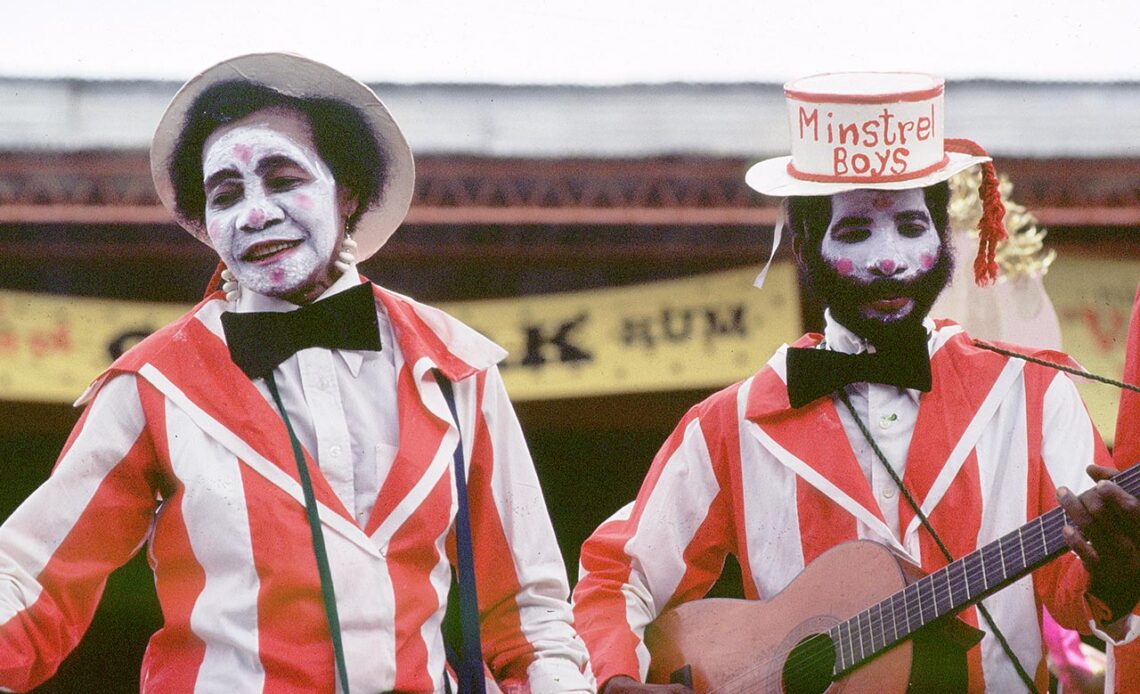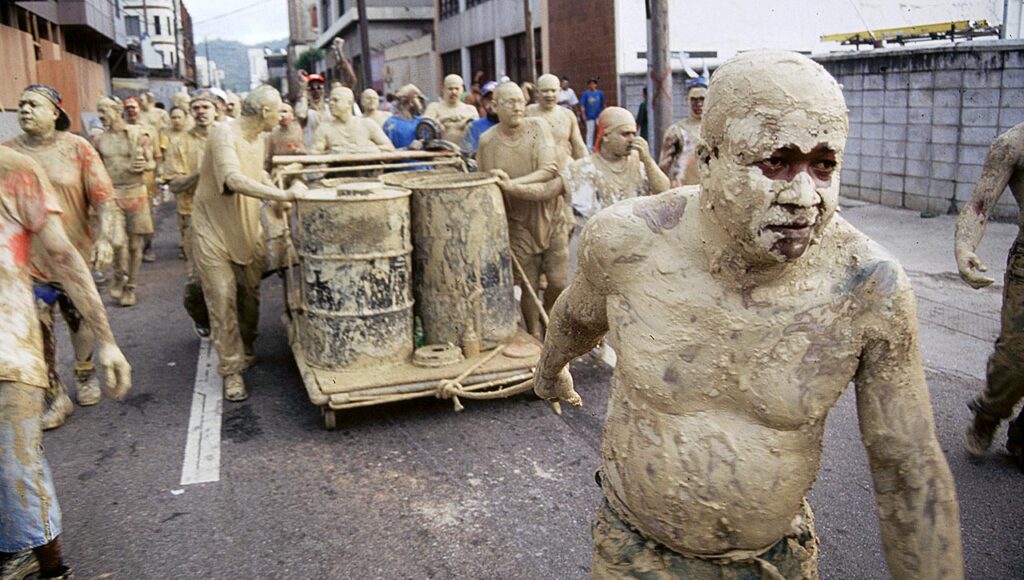
Above: Theresa Montano performing with The Minstrel Boys, 1994. Photo by Mark Lyndersay.
BitDepth#1344 for March 07, 2022
Memory is the basis of civilisation, and it is the basis of the reconstruction of our most treasured incivility, the celebration of Carnival.
My memories of Carnival span a half-century, beginning with a wonderment at the surreality that characterised the festival just five decades ago.
The trickle of individual eccentricities that sluiced down Hermitage Road in Belmont where we lived with my grandfather over the span of two Carnivals was ground zero.
The violent shuddering of a black jab, commanded by the pistol shot chatter of biscuit tins, obsidian skin glistening in the sharp light of early morning, possessed by a spirit of celebration that urged a portrayal into the realms of the supernatural.
Professional men, fair of complexion but ruddy with the dawning sun, who sauntered down the street wearing diapers while sipping from a posey as large as their heads.
But memory is treacherous, depending on multiple vectors of recollection to properly render the past.
Writing and imagery are often our most accessible resources for remembrance, but they are often wrought from singular perspectives without the experience of the senses.
We remember most truly what we have experienced, all else is reconstruction.
In distributed cognition, we consider the problem of recall in collaboration, sifting from shared experience and agreed reality.
The accuracy of the result depends a great deal on the quality of the group’s collective memory and its willingness to be ruthless in pruning errors.
Studies of collective intelligence applied to problems suggest that group cohesiveness improves results when a cohort of people works together collaboratively to an identified goal.
By any of these measures, the recording, codification and accessibility of the history of all aspects of Carnival since the first street parades of 1838 has been appalling.
Trinidad’s Carnival is in shouting distance of its 200th anniversary.
What can we say that we truly know about this festival that is convened with such passion each year?

Much of the knowledge of Carnival’s history, adaptations and production is transactive, distributed among multiple specialists and retrieved on-demand to create the event.
There has been little effort to retain or transfer this earned skill in any orderly way beyond the recent work of academia.
In 1987, the last issue of Key Caribbean’s Trinidad Carnival was published. For at least a decade, the publication, helmed by Roy Boyke and Pat Ganase, stood as a benchmark in recording each year’s festival in print.
Over the last 35 years what replaced it has increasingly been commercial, editorially underfunded Carnival magazines that reached their nadir in slick photo album books of bottoms in the road published by the largest Carnival bands exclusively for their players.
Hundreds of hours worth of interviews, performances and staged competitions of Carnival’s practitioners and creators were erased on tapes at TTT so that the cartridges could be reused. What was actually kept was left to rot through neglect and careless storage.
For its part, the NCC and its stakeholder bodies have expended uncommon effort during that time to reduce documentation of the festival to the most banal and commercial efforts possible.
Already hamstrung by the feeble records of the past, every effort was made by Carnival’s convenors and masters to stymie the creation of an informed, contemporary record of the festival.
At the turn of the century, Rubadiri Victor began an effort to record the skills and memories of what he called the golden age of creators, which he dubbed the Independence Generation, who worked between 1957 and 1980.
“More than a quarter of those traditions have since disappeared. At every turn, we were resisted by the State.” – Rubadiri Victor
At the time, he estimated that most of that talent would have died by 2012 and a youth generation would have come of age knowing little or nothing of their work.
“I identified more than 144 traditions in clear and present danger of dying because the information was only in one or two Elder’s heads and created templates for their resurrection,” Victor wrote in response to questions about the project (full statement here).
“More than a quarter of those traditions have since disappeared. At every turn, we were resisted by the State.”
What happens to cultural memory when it has no common baseline for reference? When what is remembered becomes a kind of hearsay? When tradition becomes fettered by dogma?
There is often talk, and I am guilty of mouthing this as well, of reinventing Carnival.
But how can a thing be reinvented when we have so little idea of what it was originally and find ourselves trying to reconstruct it from ever smaller fragments of memory, scattered documentation and a romantic fiction of its past?


